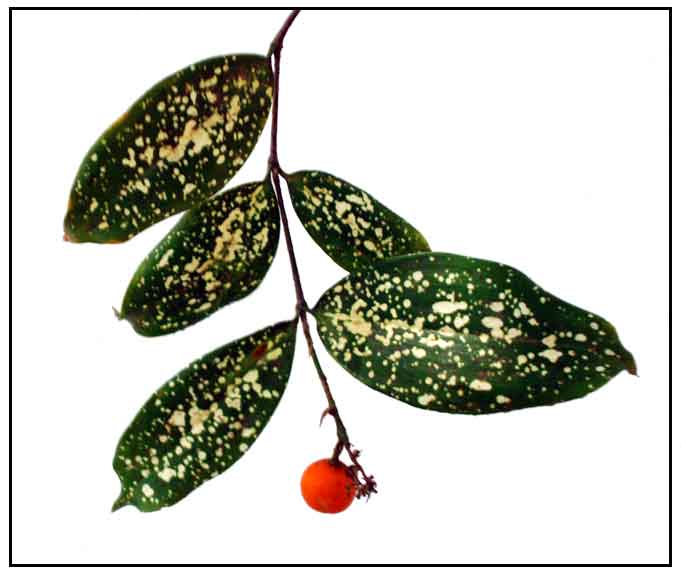 Etymology Etymology
Genus name Dracaena is derived from the Greek word "drakaina," which means "dragon" referring to the sap or juice of the stems which resembles blood. Species name surculosa means suckering. (6)
Botany
Dracaena surculosa is a small, slender shrub growing up to 2 meters, with wiry spreading stems. Leaves are opposite or whorled, elliptic or oblong-elliptic and cuspidate. Blade is thin, glossy, deep green with numerous, irregular small, yellow spots, with entire margins. Flowers are greenish. Fruit is a red berry.
The variety D. surculosa var. surculosa has a racemose inflorescence. D. surculosa var. capitata flowers in a capitate or headlike inflorescence. D. godseffiana 'Florida beauty' has leaflets almost entirely covered by creamy-white blotches. D. surculosa 'Friedman' has elliptic, olive green leaves with cream blotches and a broad ivory center band.
Distribution
- Recently introduced to the Philippines.
- Native to Congo.
Constituents
- Study of whole plant isolated nine steroidal saponins, including three new bisdesmosidic spirostanol saponins, surculosides A, B, and C (1-3), and a new bisdesmosidic furastanol saponin (4). (see study below) (1)
- Study isolated two new 3,5-cyclospirostanol saponins (1, 2) and two new 3,5-cyclofurostanol saponins (3, 4), established as (24S,25R)-1b-[(b-D-fu- copyranosyl)oxy]-6b-hydroxy-3a,5a-cyclospirostan-24-yl b-D-glucopyranoside (1), (24S,25R)-1b-[(b-D-glucopyra- nosyl)oxy]-6b-hydroxy-3a,5a-cyclospirostan-24-yl b-D-glucopyranoside (2), (25S)-1b-[(b-D-glucopyranosyl)oxy]- 6b-hydroxy-22a-methoxy-3a,5a-cyclofurostan-26-yl b-D-glucopyranoside (3), and (25S)-1b-[(b-D-fucopyra- nosyl)oxy]-6b-hydroxy-22a-methoxy-3a,5a-cyclofurostan-26-yl b-D-glucopyranoside (4), respectively. (2)
Uses
Folkloric
• No known medicinal folkloric use in the Philippines.
• Dracaena produces a bright red resin - dragon's blood - used medicinally in ancient times.
• In Sierra Leone, used to increase fitness and physical strength in children. Decoction of boiled leaves used to bathe a child twice a day. About 50 cc of the decoction sometimes drunk concurrently. (5)
Studies
• Steroidal Saponins / Cytotoxicity:
Phytochemical study isolated nine steroidal saponins, including three new bisdesmosidic spirostanol saponins–surculosides A, B and C and a new bisdesmosidic furostanol saponin. The isolated saponins were evaluated for their cytotoxic activity against HL-60 human promyelocytic leukemia cells. (1)
• Steroidal Saponins: Study isolated two new 3,5-cyclosspirostanol saponins (1,2) and two new 3,5-cyclofurostanol saponins (3,4). (see constituents above) (2)
• Peroxidase Activity / Roots: In a study of four different varieties of plant roots for peroxidase activity, spotted dracaena gave the highest peroxidase activity with 361.07 M/ml. Peroxidase has the potential for use in removal of water contaminated with phenols. Plant peroxidase presents an efficient and low cost alternative, with no by-product formation. (6)
Toxicity
• Reported toxicity to cats. (4)
Availability
Cultivated. |

![]()

